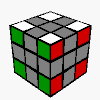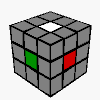Rubik's Cube basics
Pieces
If you take your Rubik's cube apart, you will find that it is made from 21 separate pieces:

|
12 edge pieces, each having 2 sides, |

|
8 corner pieces, each having 3 sides, |

|
And finally, 1 centre piece, having 6 sides. |
Position
Each piece has a position representing where that piece is.

|
For example, the two front edges in the cube to the left have swapped positions. |
- Each edge piece can be in one of 12 edge positions.
- Each corner piece can be in one of 8 corner positions.
- The centre piece can only be in the centre position, i.e. it is immovable.
Orientation
Each piece has an orientation representing which direction a piece is facing.

|
For example, the two front edges in the cube to the left have correct positions, but flipped orientations. |
- Each edge piece has two possible orientations.
- Each corner piece has three possible orientations.
- The centre piece has 24 possible orientations.
States
When considered separately, each piece has 24 possible states:
- An edge piece has 12 positions * 2 orientations = 24 states.
- A corner piece has 8 positions * 3 orientations = 24 states.
- The centre piece has 1 position * 24 orientations = 24 states.
When considered simultaneously, not just any combination of these states is possible. For example, two pieces cannot be in the same position at the same time. Further, only a small fraction (1 in 12) of the remaining conceivable states are actually reachable by legal moves. i.e. If you take your Rubik's cube apart and put it back together in some random configuration, there is only a 1 in 12 chance that the cube will be solvable by legal moves.
Moves
Various kinds of move can be performed on the cube. These can be viewed by clicking the "play" button on each applet:
(The interactive Rubik's Cube applet used below was developed by Josef Jelinek)
| 90, 180 and 270 degree rotations through the first plane. | |
| Rotations through the second plane. | |
| Rotations of the whole cube. Usually counted as 0 moves. | |
| Simultaneous rotations through two planes. Usually counted as 2 simultaneous moves. |
Solution
A solution is a sequence of moves that causes the cube to reach some goal state.
In the following example, we would like to join the two coloured pieces. The solution given is two moves:
|
Click "play" to show the solution. |
Typically, the end goal is to solve all pieces of the cube, i.e. putting them into their correct positions and orientations.
Symmetry
Two cube states are symmetric if one is a rotation or reflection of the other. In such cases, either cube can be solved using a rotation or reflection of the solution to the other cube.
The following cubes are all equivalent due to symmetries:
| Original | Colour rotation | Reflection | Cube rotation |
As a result, all 4 cases can be solved using rotations and/or reflections of the same general solution.